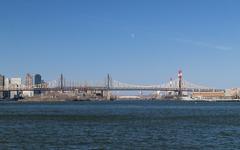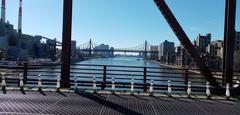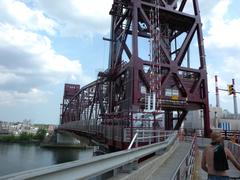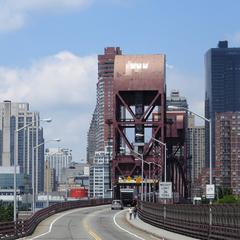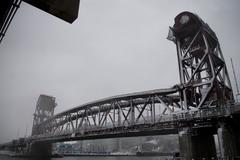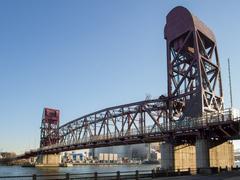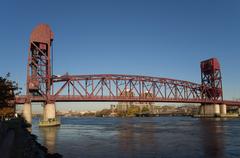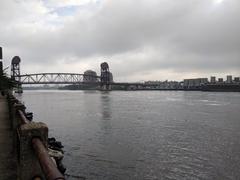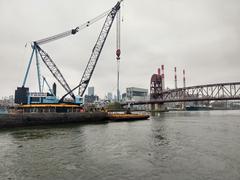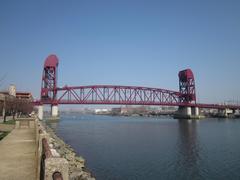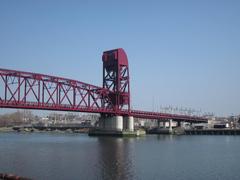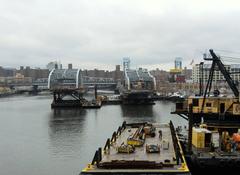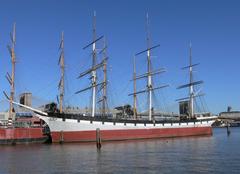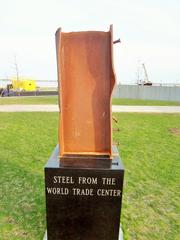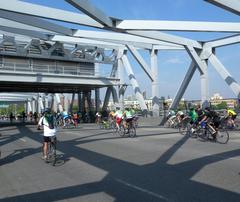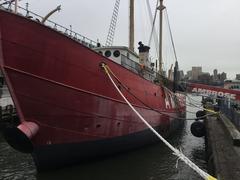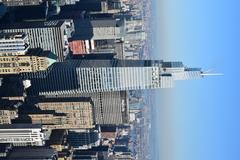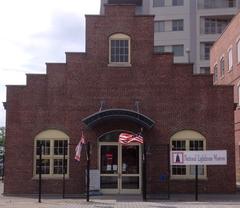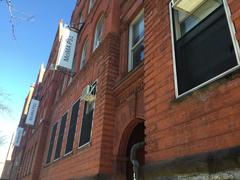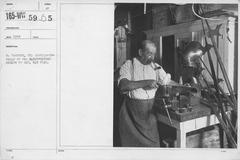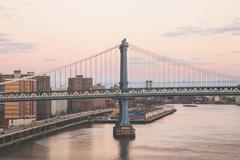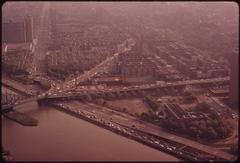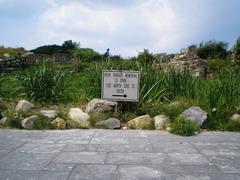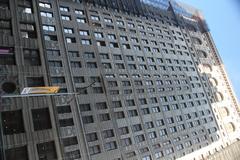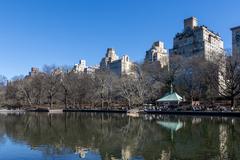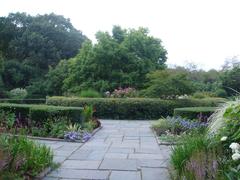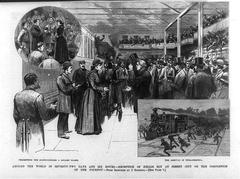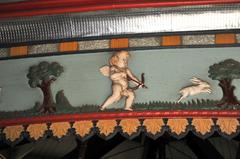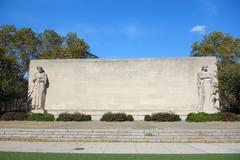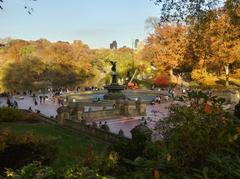
Visiting Roosevelt Island Bridge: Hours, Tickets, and Tips
Date: 01/08/2024
Why Visit Roosevelt Island Bridge?
The Roosevelt Island Bridge is not just a vital transportation link; it is a piece of New York City history and an architectural marvel. Constructed to connect Roosevelt Island to Queens, this bridge has been a crucial infrastructure piece since its completion in 1955. Initially known as the Welfare Island Bridge, it played a significant role in transforming the island from an isolated area accessible only by ferry or trolley into a thriving residential community. This guide aims to provide a comprehensive overview of the Roosevelt Island Bridge, encompassing its early history, architectural design, and modern-day significance. Additionally, practical information on visiting hours, travel tips, and nearby attractions will be provided to enhance your visiting experience. Whether you are a history enthusiast, architecture aficionado, or a curious traveler, the Roosevelt Island Bridge and its surrounding attractions offer a rich tapestry of experiences for everyone (Wikipedia) (Visit NYC).
Table of Contents
- Introduction
- Early History and Construction
- Architectural Design
- Role in Island Development
- Modern-Day Significance
- Maintenance and Upgrades
- Visitor Information
- Nearby Attractions
- Future Prospects
- Events and Festivals
- Accessibility and Visitor Tips
- Safety Tips
- FAQ
- Conclusion
Introduction
The Roosevelt Island Bridge is not just a vital transportation link; it is a piece of New York City history and an architectural marvel. This article explores the bridge’s history, design, significance, and provides practical information for visitors, including visiting hours, ticket prices, and travel tips. Whether you are a history buff, an architecture enthusiast, or a curious traveler, the Roosevelt Island Bridge offers something for everyone.
Early History and Construction
The Roosevelt Island Bridge, originally known as the Welfare Island Bridge, was constructed to connect Roosevelt Island to Queens in New York City. Completed in 1955, the bridge provided a crucial link for vehicular traffic to the island, which had previously been accessible only by ferry or a trolley that ran along the Queensboro Bridge. The construction was part of a broader effort to improve infrastructure and accessibility to the island, which was undergoing significant changes at the time.
Architectural Design
The Roosevelt Island Bridge is a lift bridge, a type of movable bridge that allows for the passage of boat traffic by lifting a section of the roadway. This design was chosen due to the navigational needs of the East River, which sees a considerable amount of maritime traffic. The bridge’s lift span is 418 feet long, and it can be raised to a height of 100 feet above the water, allowing for the passage of large vessels. The bridge’s total length is approximately 2,877 feet, making it a significant engineering feat of its time.
Role in Island Development
The construction of the Roosevelt Island Bridge played a pivotal role in the development of the island. Before the bridge, the island was relatively isolated, with limited access to the rest of New York City. The bridge facilitated easier transportation of goods and people, which was essential for the island’s transformation from a place of confinement and medical treatment to a residential community. The bridge’s opening coincided with the island’s renaming from Welfare Island to Roosevelt Island in 1973, reflecting its new identity and purpose.
Modern-Day Significance
Today, the Roosevelt Island Bridge remains a vital piece of infrastructure for the island’s residents and visitors. It provides the only vehicular access to the island, making it indispensable for daily commutes, emergency services, and deliveries. The bridge also supports pedestrian and bicycle traffic, contributing to the island’s walkability and connectivity. The bridge’s lift mechanism is still operational, ensuring that maritime traffic on the East River can pass without hindrance.
Maintenance and Upgrades
Over the years, the Roosevelt Island Bridge has undergone several maintenance and upgrade projects to ensure its safety and functionality. In 2011, a significant rehabilitation project was undertaken, which included structural repairs, mechanical and electrical system upgrades, and the installation of new lighting. These improvements were necessary to extend the bridge’s lifespan and enhance its reliability. The project was completed with minimal disruption to traffic, demonstrating the importance of the bridge to the island’s daily life.
Visitor Information
Visiting Hours and Tickets
The Roosevelt Island Bridge does not have specific visiting hours as it is a public thoroughfare. However, if you intend to explore the island, most attractions and parks are open from dawn to dusk. There are no ticket fees to cross the bridge.
Travel Tips
- Getting There: The bridge is easily accessible from both the Queens and Roosevelt Island sides. On the Queens side, it connects to Vernon Boulevard. On the Roosevelt Island side, it connects to Main Street.
- Public Transportation: The bridge is well-integrated with the island’s public transportation system, including the Red Bus shuttle, which provides free transportation around the island.
- Biking and Walking: The bridge supports pedestrian and bicycle traffic, offering unique views of the East River and the Manhattan skyline.
Nearby Attractions
Franklin D. Roosevelt Four Freedoms Park
Located at the southern tip of Roosevelt Island, the Franklin D. Roosevelt Four Freedoms Park is a tribute to President Franklin D. Roosevelt’s famous speech. Designed by architect Louis Kahn, the park offers a serene environment with stunning views of the United Nations headquarters and the Manhattan skyline. The park is a popular spot for public programming and family-friendly events, making it a must-visit for tourists. Visiting Hours: Open daily from 9 AM to 5 PM.
Renwick Ruin (Smallpox Hospital)
One of the most intriguing historical sites on Roosevelt Island is the Renwick Ruin, the remnants of a smallpox hospital designed by James Renwick Jr. This Gothic Revival structure, built in 1856, is a hauntingly beautiful ruin that offers a glimpse into the island’s past as a quarantine site for smallpox patients. The ruin is located within Southpoint Park, which also features walking paths and scenic views of the East River. Visiting Hours: Open daily from dawn to dusk.
Roosevelt Island Lighthouse
At the northern tip of the island stands the Roosevelt Island Lighthouse, built in 1872 by architect James Renwick Jr. The lighthouse offers panoramic views of the East River and the Manhattan skyline. The surrounding Lighthouse Park is a peaceful area perfect for picnics and leisurely strolls. The lighthouse is a popular spot for photography, especially during sunrise and sunset. Visiting Hours: Open daily from dawn to dusk.
Cornell Tech Campus
The Cornell Tech Campus is a modern addition to Roosevelt Island, featuring state-of-the-art facilities and innovative architecture. The campus is home to several tech companies and startups, making it a hub of innovation and education. Visitors can explore the campus grounds, which are beautifully landscaped and offer stunning views of the city. The campus also hosts various public events and lectures, adding to the island’s vibrant community life. Visiting Hours: Open daily, specific hours vary for events.
Southpoint Park
Southpoint Park is a tranquil green space located on the southern end of Roosevelt Island. The park features walking paths, picnic areas, and scenic viewpoints. It is also home to the Renwick Ruin and the Franklin D. Roosevelt Four Freedoms Park. Southpoint Park is an excellent spot for a leisurely stroll or a relaxing afternoon, offering stunning views of the East River and the Manhattan skyline. Visiting Hours: Open daily from dawn to dusk.
Roosevelt Island Historical Society Visitors’ Kiosk
For those interested in the island’s rich history, a visit to the Roosevelt Island Historical Society Visitors’ Kiosk is a must. Located near the tram station, the kiosk provides detailed information about the island’s historical sites and offers guided tours. The kiosk is an excellent starting point for exploring the island’s many historical landmarks, including the Renwick Ruin, the Octagon Tower, and the Roosevelt Island Lighthouse. Visiting Hours: Open daily from 11 AM to 5 PM.
The Octagon
The Octagon is another historical landmark on Roosevelt Island, originally built as the main entrance to the New York City Lunatic Asylum in 1839. Today, the Octagon has been repurposed as a residential building, but its historical significance remains. The building’s unique architecture and historical background make it a fascinating site to visit. The Octagon also features a gallery that showcases art and historical exhibits. Visiting Hours: Open daily, specific hours vary for the gallery.
Waterfront Promenade
The waterfront promenade that encircles Roosevelt Island offers some of the best views of Manhattan and Queens. The promenade is perfect for a leisurely walk, jog, or bike ride. Along the way, visitors can enjoy the island’s lush greenery, historical landmarks, and scenic viewpoints. The promenade is also a popular spot for fishing and bird-watching. Visiting Hours: Open daily from dawn to dusk.
Future Prospects
Looking ahead, the Roosevelt Island Bridge will continue to play a crucial role in the island’s development. As Roosevelt Island evolves with new residential and commercial projects, the bridge’s importance as a transportation link will only grow. Future plans may include further upgrades to the bridge’s infrastructure to accommodate increased traffic and ensure its continued reliability. The bridge’s historical and architectural significance will also be preserved, making it a lasting symbol of the island’s transformation and progress.
Events and Festivals
Roosevelt Island hosts a variety of events and festivals throughout the year, adding to its vibrant community life. The Franklin D. Roosevelt Four Freedoms Park often hosts public programming and family-friendly events. Additionally, the island’s parks and open spaces are frequently used for cultural festivals, outdoor concerts, and community gatherings. These events provide a unique opportunity to experience the island’s community spirit and cultural diversity. Event Schedules: Vary throughout the year; check local listings.
Accessibility and Visitor Tips
Roosevelt Island is easily accessible via the Roosevelt Island Tramway, the F line of the New York City Subway, the Q102 bus, and the NYC Ferry’s Astoria line. For those driving, the Roosevelt Island Bridge connects the island to Queens. The tramway is particularly popular for its scenic views and operates every 7-15 minutes. Visitors are encouraged to start their visit at the Roosevelt Island Historical Society Visitors’ Kiosk for maps and information.
Wheelchair Accessibility
Both the Roosevelt Island Tramway and the subway stations on the island are wheelchair-accessible. However, occasional outages may affect accessibility, so it’s advisable to check the status of these services before planning your visit.
Elevators and Ramps
The island is equipped with elevators and ramps to ensure accessibility for all visitors. The tramway station and subway station both have elevators, and the island’s main attractions are designed to be accessible to those with mobility challenges (Visit NYC).
Safety Tips
Emergency Services
Roosevelt Island has its own post office and fire station, and emergency services are provided from Queens. In case of emergencies, visitors can rely on these services for assistance.
Weather Precautions
During the summer months, temperatures can soar, so it’s important to stay hydrated and wear appropriate sun protection. In winter, be prepared for cold weather and possible snow, which can affect transportation services (Musings and Adventures).
FAQ
Q: Is Roosevelt Island accessible by public transportation? A: Yes, Roosevelt Island is accessible by the Roosevelt Island Tramway, the F line of the New York City Subway, and the NYC Ferry service.
Q: What are the best times to visit Roosevelt Island? A: To avoid crowds, consider visiting during weekdays or early mornings. The tramway operates seven days a week, with extended hours on weekends.
Q: Are there any guided tours available on Roosevelt Island? A: Yes, guided tours are available and can provide valuable insights into the island’s history and attractions. Check local listings for tour schedules and availability.
Q: What are the ticket prices for the Roosevelt Island Tramway? A: The Roosevelt Island Tramway uses the same fare system as the New York City Subway, so a MetroCard can be used for both.
Conclusion
The Roosevelt Island Bridge stands as more than just a functional piece of infrastructure; it is a testament to the historical and ongoing development of Roosevelt Island. From its early days as a lifeline for an isolated community to its current role as a vital link for residents and visitors, the bridge has been integral to the island’s story. Its architectural design, historical significance, and modern-day functionality make it a fascinating subject for anyone interested in the history and development of New York City. Future prospects for the bridge include further upgrades to accommodate increased traffic and ensure continued reliability, solidifying its importance as Roosevelt Island evolves with new residential and commercial projects. Visiting Roosevelt Island provides a unique blend of historical landmarks, scenic views, and modern amenities, making it a must-visit destination in New York City. Plan your visit today to explore all that this remarkable island and its iconic bridge have to offer (Loving New York) (Musings and Adventures).
References
- Wikipedia. (n.d.). Roosevelt Island Bridge. Retrieved January 8, 2024, from Wikipedia
- Visit NYC. (n.d.). The Roosevelt Island Tram. Retrieved January 8, 2024, from Visit NYC
- Loving New York. (n.d.). Roosevelt Island Tramway. Retrieved January 8, 2024, from Loving New York
- Musings and Adventures. (2018, July 17). 10 Things to Do on Roosevelt Island: A Cheap Day Trip in NYC. Retrieved January 8, 2024, from Musings and Adventures

